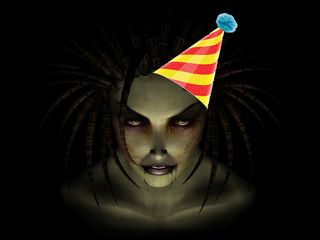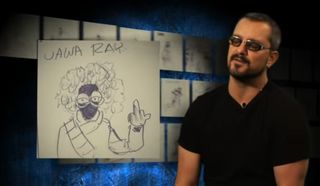
Blizzard turned 25 this year, and we've planned a whole week of coverage to celebrate. We already looked at the history of its games on PC, the story behind Battle.Net, and even a look at the origin of the Blizzard name. But beyond the games, what was it like to work at Blizzard in the early '90s?

This week, we looked back at 25 years of Blizzard, speaking to people who've been there from the start. We learned the story of Battle.Net, how Blizzard got its name, made a complete history of its PC games, and more.
We did a dozen interviews with some of Blizzard's most veteran developers, dug through old anniversary videos, and even looked at a few books to find out. We've gathered quotes and stories from the people that were there from beginning to help paint a picture of what the office was like. Shoes weren't required, getting lunch as a team was a daily ritual, and Samurai Shodown skills were a must.
Here's what the early culture of Blizzard was like, straight from the mouths of the people who were there—along with a few places to hear more from them.
Five years ago, Blizzard put together a 20th anniversary retrospective video, with founders and longtime employees recalling everything from the studio's founding through 2011. Co-founders Mike Morhaime and Allen Adham speak at one point about their hiring standards:
MM: "When we first started, we had this idea that we were looking for smart, passionate people who loved games and loved learning about game development. We just wanted to make great games, it was as simple as that. I think the pre-Warcraft: Orcs & Humans era of Blizzard really allowed us to grow the talent pool at the company."
AA: "Our biggest [hiring] criteria was we wanted kinda cool people who we thought would vibe well with the company who played video games, and that applied to everybody. [For programmers,] we just wanted guys who were really into games and really into computer coding."
Bob Fitch, Engineering Director and 25 year veteran of Blizzard, on the earlier office culture:
PC Gamer Newsletter
Sign up to get the best content of the week, and great gaming deals, as picked by the editors.
We didn't have designers back then, we were all designers. Everybody helped contribute to the game, and that continued all the way on.
Bob Fitch, Engineering Director
"It was very relaxed. We were all focused on game playing, so all of our time when we weren't working we would hang around this TV that was in the common room and watch people playing Samurai Shodown, or we'd play Rock n' Roll Racing on there ourselves. I'd play Rock n' Roll Racing against Frank Pearce all the time. It was very, very casual, the kind of clothing you wore was just jeans and a t-shirt, flip-flops. We had a guy who walked around barefoot all the time. Very very casual.
"We didn't have designers back then, we were all designers. Everybody helped contribute to the game, and that continued all the way on, until even when we had designers. Now it's part of our culture. Every voice matters is one of our core values of the company, and it's really true. All of the core values are really true. One of the things I really like about working at Blizzard, we take the core values seriously. Gameplay first. We'll never ship a game before it's done from our point of view, and our point of view is often that it needs to be much more polished than I think the average person might expect a game to be. I think that's helped us a lot, of course."
Frank Pearce, Blizzard co-founder:
"There was a lot of bliss to be had in the fact that we didn’t know what we didn’t know. There was a lot of bliss to be found in that, because you just do what you gotta do. You try, rinse, and repeat—trial and error till you get it right, till you get it the way you want."
Bob Fitch on Blizzard getting bigger:
"If you grow up with it, you kind of don't notice [how it's grown] until you take moments to look back. I had a son who was born at the same time I was trying to ship StarCraft. Now he's in college, and moved away, and along the way you don't really notice it as much, but all of a sudden you stop and think, wow, he's off in college. The same thing happened here. We were 11 people at the beginning, working on Lost Vikings and Rock n' Roll Racing and all that, and it was probably 2-3 years before we were up to 24 people, and nothing seemed unusual about a company growing to 20 people. Another factor, as you add more and more people and the company gets bigger, they're off in different parts of the building, so maybe you're not seeing that they're there all the time. But then you go one day to the company Christmas party and it fills a whole banquet hall and you go "Wow, this really is getting kind of big." And then a few years later you go to a Christmas party and you fill up three banquet halls. It's kind of surreal in a way you can't explain easily. All I can compare it to is watching the kids grow up. You don't see it as it's happening, and then you look back and realize just how big it's been, and you kind of wonder how you got from there to here.
I would even go so far as to say that the foundation of what Blizzard is today was built on a bedrock of karaoke, Samurai Shodown, and Jack and Coke."
Excerpt from a book by Micky Neilson
"We used to go to lunch together, the entire company. All 11 of us would go to lunch together to the same place. We'd pick out where we were going to go, we'd all show up and take 2 or 3 tables. We'd go to Del Taco or Carl's Jr. or whatever. And then over time we had to start splitting up into two groups because it was just getting to be a little too much. And over time—it's kind of funny, but I think of it in terms of those lunches. When the lunch crew had to start breaking down into smaller and smaller bits, that's how I was realizing we were getting bigger."
You could even credit Blizzard's communal culture as part of the inspiration for Battle.net. On the 20th anniversary video, Allen Adham called Battle.net a "no-brainer" because it was so much more satisfying to whoop your friends at a game than a computer AI. They played games around the office all the time.
AA: Everyday after work, and during work, we'd be playing Samurai Shodown, or Street Fighter, or Mortal Kombat.
Samwise Didier: One of my claims to fame is I actually defeated Roman Kenney in Street Fighter 2 using my feet. And I would also make sure that after that game, anyone else that wanted to play me played wit the foot controller. So they got my funk on my hands, and I would defeat them too.
Seriously, SNK's fighting game Samurai Shodown was a big deal. Micky Neilson, former writer/publishing lead and 22-year veteran of Blizzard, left Blizzard earlier this year and released a book called "Lost and Found: An Autobiography About Discovering Family". While it's about his entire life, untold stories about Blizzard's early years are revealed throughout, including the following excerpt about the culture around the time of Warcraft 2's development:
"During that time period Thursday night was karaoke night. [Chris] Metzen, Sammy [Samwise Didier], and Roman [Kenney] especially had amazing voices... We all worked together, and we all partied together, and one informed the other. We forged lifetime bonds and friendships, and along with the execs, we were the core of the company. I would even go so far as to say that the foundation of what Blizzard is today was built on a bedrock of karaoke, Samurai Shodown, and Jack and Coke."

Other colorful stories from the book include Highlander TV show nights at Allen Adham's house, all sorts of Chris Metzen pranks, and Neilson and another Blizzard employee being background extras in a porno called Blondage. He also mentioned the Jawa wall, which Samwide Didier and Chris Metzen reminisced about in the 20th anniversary video.
SD: It was a lot of geeks playing a lot of different games, listening to heavy metal and rock & roll.
CM: There were a lot of shenanigans. Yahoos running around with nerf guns.
Nobody knows how the Jawa wall came to be.
CM: One day someone got ahold of a little yellow block of post-it notes and drew a Jawa.
SD: People started screwing with the integrity of the Jawa name.
CM: All these artists are drawing, we had one with a particularly big afro, big glasses, very angry, flipping the bird, and that was Jawaray Hall [after Blizzard's Joeyray Hall].
SD: Mixing it up with classic heroes, like Jawan Wayne.
CM: Jawaptimus Prime.
SD: From Samurai Shodown, Jawan Fu. And then, days later, it was gone. Like a shadow of a memory. I still look back to those days with longing. But alas, they are no more. Thanks HR.
Mike Morhaime, Allen Adham and cinematics artist Joeyray Hall talked about how lean Blizzard ran in its early years, often barely staying afloat on borrowed money. They'd always put new funds right back into the company, hiring more talent. From the 20th anniversary video:
JH: In the early years the company pretty much lived on royalties of the games we worked on. But there were times when there just wasn't enough money to pay salaries.
MM: On paper it always looked like we were just a couple months away from being completely in the black and having a windfall of excess cash to work with, and it never really happened.
AA: Mike and I tried to shelter everybody from anything other than making the games.
MM: We figured out you could actually get interest-free advances on your Discover card by going to the supermarket and getting cash back.
JH: They would cash in their credit cards and put the money in the bank account so they could still make payroll.
AA: It's really a miracle that we never missed a payroll. We were always a week away from being unable to make payroll.
JH: Some people knew about this and some people didn't. Those of us that did, we know the kind of people these men are, and we knew then that we'd work for these people forever.
MM: The company grew beyond the point where our Discover cards couldn't handle it anymore, so we each went to our parents and got them to put $20,000 into a bank account. So $40,000. At the time we sold the company to Davidson & Associates, we'd completely maxed out the $40,000 credit line. So yeah, it was pretty tight for the first few years.
At this year's BlizzCon, Sean "Day9" Plott hosted a 25th anniversary panel with many of the people quoted above, discussing lots of different games and full of stories. You can watch it on YouTube here (no telling how long before it's taken down though) or officially on the BlizzCon site if you purchased a 2016 Virtual Ticket.
And for even more inside stories, we've put together a complete history of Blizzard games on PC with exclusive interviews and stories.
Most Popular





